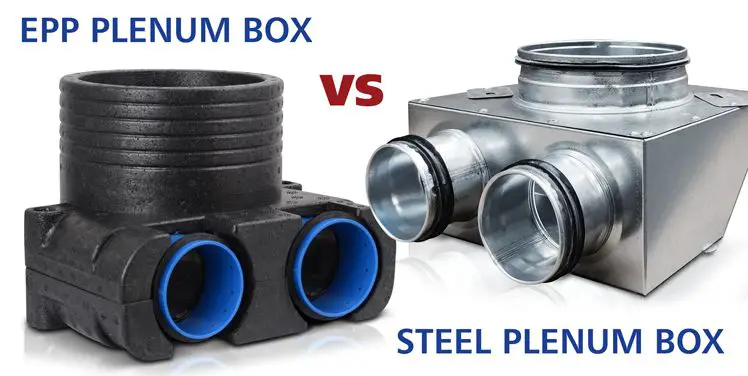What Is A Plenum Box?
What is a Plenum Box?
A plenum box is a type of electrical junction or outlet box that is specially designed for use in ventilation plenums and air-handling spaces. The main purpose of a plenum box is to contain electrical connections and wiring away from circulating air.
Unlike standard electrical boxes, plenum boxes are constructed from noncombustible materials and designed not to allow flames or excessive smoke to spread in the event of an electrical fire. This helps prevent toxic fumes and smoke from quickly circulating through ductwork to occupied areas of a building.
Plenum boxes differ from standard electrical boxes in their materials, design, and installation methods. They have specific fire resistance and low flame and smoke spread ratings that meet code requirements for installation in space used for air movement in HVAC systems. Standard boxes do not meet these ratings and cannot be installed in plenum spaces.
Plenum vs Non-Plenum
The key difference between plenum and non-plenum spaces is the way air circulates within the space. A plenum is an air intake chamber or duct specifically designed for HVAC and air circulation in a building. Plenum spaces include areas like raised floors, drop ceilings, air ducts, and mechanical shafts. These spaces allow air to flow freely throughout the building for ventilation and air conditioning.
Non-plenum spaces don’t facilitate airflow and include areas like walls, occupied rooms, and electrical closets. The National Electrical Code (NEC) has special safety requirements for wiring and electrical equipment installed in plenum spaces due to the increased risk of spreading smoke and toxic fumes in a fire.
According to NEC Article 300.22(C), all wiring and equipment in plenum spaces must be either plenum rated or installed in metal conduit. Plenum ratings indicate the wiring or equipment meets fire safety standards and emits low smoke and flame spread. Non-plenum rated wiring gives off toxic fumes when burned and can rapidly spread fire through plenum spaces, endangering lives. Properly installed plenum boxes, plenum cable, and other plenum rated items prevent this.
Understanding the difference between plenum and non-plenum areas is crucial when installing electrical systems to meet code and ensure safety. Plenum spaces require special materials, but offer benefits like flexible routing for cable runs.
Plenum Box Construction
Plenum boxes are constructed with specific materials and properties necessary to allow their safe installation in plenum spaces.

They are made of metal, usually steel or aluminum, which provides sturdiness and fire resistance. The metal construction also allows for grounding in compliance with electrical code requirements.
Plenum boxes have specialized gaskets and seals to prevent leakage of air from the plenum space into the box. This helps maintain the integrity of the plenum as an air return path.
Additionally, plenum boxes must be made with fire resistant materials that meet the flame spread and smoke development standards required by building codes for plenum installation. This prevents the plenum box from contributing to fire spread in a building.
Proper construction using metal materials, gasketing, and fire resistant components enables plenum boxes to be safely installed in the plenum space to hold electrical connections while minimizing risks.
Plenum Box Installation
Plenum boxes are installed in open plenum spaces like drop ceilings or raised floors (FIELD INSTALLATION INSTRUCTIONS FOR …). Because these spaces allow air to flow freely, plenum boxes must be properly sealed to prevent leaks. Per code requirements, all seams and joints must be sealed with firestop putty or caulk to contain fire and smoke. The putty/caulk creates an airtight barrier while allowing some flexibility for the metal to expand and contract.
To install a plenum box, start by wrapping the exterior with the recommended insulating material like fiberglass duct wrap. Make sure to wrap all four sides, sealing the vertical seams with a minimum 1” overlap. Use metal screws or bolts to firmly attach the wrapped plenum box to rigid structural supports. Apply a thick bead of UL-rated firestop putty or caulk at every corner and seam. Spread the putty/caulk with a putty knife or finger to create an airtight seal about 1/4” thick. Wipe away any excess. Once sealed, the plenum box can be connected to duct runs leading to and from air supply equipment.
Proper installation ensures the plenum box does not compromise the fire resistance rating of the plenum space. It also prevents air leakage that could reduce HVAC system efficiency and performance.
Plenum Box Code Requirements
Plenum boxes must meet specific code requirements outlined in the National Electrical Code (NEC). Key sections include:
300.22(C)(1) covers the use of plenum boxes in other spaces used for environmental air. It states that wiring methods like electrical metallic tubing, electrical nonmetallic tubing, and mineral-insulated metal-sheathed cable are permitted to be installed in ducts or plenums or other spaces used for environmental air, provided they are marked for plenum use and installed per code requirements (source).
In addition, plenum boxes must be UL-listed and labeled specifically for plenum use. The UL mark ensures the product has passed safety testing and meets the more stringent fire resistance standards for plenum spaces. Plenum boxes are constructed with non-combustible and low-smoke producing materials.
Plenum Box vs Plenum Cable
There is an important difference between plenum boxes and plenum cables. Plenum boxes are metal or plastic junction boxes that are specially designed for use in plenum spaces. They have seals and gaskets to prevent air leakage. Plenum cables have a special fire-retardant jacket that produces less smoke and toxic fumes when burned. They are rated CMP or CMR.
Plenum boxes are required by code in plenum spaces to contain any electrical connections and equipment. This prevents exposed wires or equipment from being a fire hazard. Plenum cables are only required in plenum spaces if they are not enclosed in conduit. If you run cables inside plenum-rated conduit, you can use standard non-plenum cables 1.
The key difference is that plenum boxes are always required when installing junction boxes and devices in plenum spaces. Plenum cables are only required when running exposed cables in plenum spaces. If enclosed in conduit, standard cable can be used.
Cost of Plenum Boxes
Plenum boxes are more expensive than standard electrical boxes due to the fire-rated materials used in their construction. The metal is thicker and more rigid, and internal components are made from non-flammable materials. This added fire resistance comes at an increased cost.
A typical plenum-rated electrical box may cost 2-3 times more than a standard electrical box. According to Homewyse, the total cost to supply and install a plenum box ranges from $1168-$1395 per box as of January 2024. This is significantly higher than a regular electrical box which may only cost $5-$50 depending on size and type.
The exact premium paid for a plenum-rated box depends on size, construction, and accessories needed inside the box. Metal thickness, number of knockouts, volume, and additional fire stopping materials impact the base cost. Prices also vary based on brand, dealer, and geographic location.
In summary, plenum boxes require fire-rated components that increase their cost compared to standard electrical boxes. The premium paid provides enhanced safety for routing cables through plenum spaces.
Plenum Box Sizes
Plenum boxes come in a variety of standard sizes to accommodate different duct and diffuser configurations. Some common plenum box sizes include:
- 12″ x 12″
- 16″ x 16″
- 24″ x 24″
- 36″ x 36″
According to Eaton-Williams in their Model CD brochure, standard plenum box sizes are suitable for diffuser lengths up to 3.0m for 1 slot diffusers, 1.8m for 2 slot diffusers.
It’s important to choose a plenum box size that matches the dimensions of the ductwork as closely as possible. The box should also be large enough to accommodate any internal dampers or other hardware.
Matching covers are available for most standard plenum box sizes. The covers attach to the box once it’s installed and help provide an air-tight seal. Having the correctly sized cover is crucial for proper airflow and ventilation.
Plenum Box Applications
Plenum boxes are commonly used in commercial HVAC systems to distribute conditioned air throughout a building. The large open spaces above drop ceilings in offices, hospitals, schools, and other commercial buildings provide an ideal location for running ductwork and installing plenum boxes.
Compared to residential systems, commercial HVAC systems require moving much higher volumes of air which is why plenum boxes become necessary. They allow the central air handlers on the roof or in mechanical rooms to connect to the network of ducts spreading air across all rooms and floors. Plenum boxes serve as junction points to divide and direct the airflow.
While plenum boxes could technically be installed in residential systems, they are rarely used in homes. Residential systems usually have simpler duct layouts that don’t require the branching and airflow control that plenum boxes provide. Homes ductwork is often limited to supplies and returns to individual rooms. According to this article, plenum boxes are “almost exclusively used in commercial settings.”
Advantages of Plenum Boxes
Plenum boxes provide several key advantages compared to running cables openly through plenum spaces:
Plenum boxes allow wiring to be run safely through plenum spaces in accordance with building and fire codes. Building codes typically prohibit openly running cables through plenum spaces due to fire hazards, but plenum boxes provide an enclosed, fire-resistant pathway for cables that meets code requirements (Source).
Plenum boxes are constructed with fire-resistant materials, providing protection in the event of a fire. The metal construction and fire-retardant sealants used in plenum boxes prevent the spread of flames through plenum spaces. This fire-resistant construction allows cables inside plenum boxes to be run through plenum spaces when open cabling would not meet fire codes (Source).
By safely allowing wiring through plenum spaces, plenum boxes provide more flexible routing options for cables in buildings. Cables can take more direct routes through plenum spaces rather than having to be routed around the plenum.
Overall, plenum boxes enable wiring to be installed in compliance with building codes, while also providing enhanced fire safety compared to open cabling in plenum spaces.


